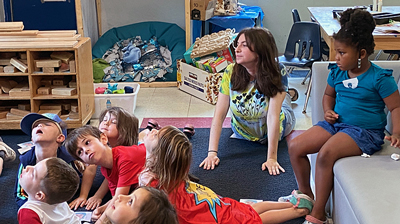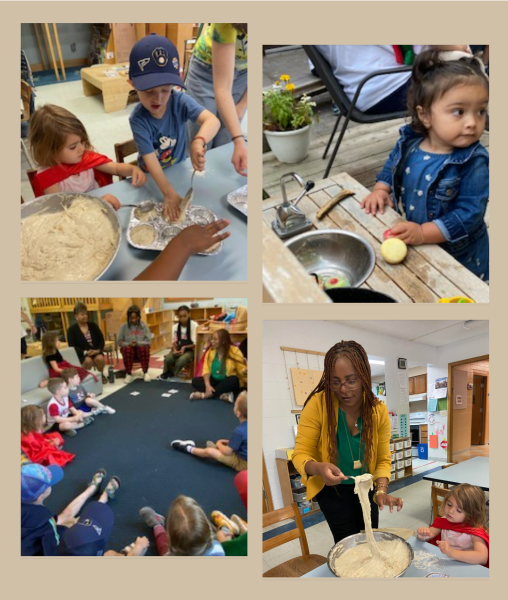New Project Addresses Need for Diverse School Materials for Jewish Children of Color
Shalom Curriculum Project to survey educators and parents, prototype and test revised materials in pre-schools
September 13, 2023 | By WCER Communications

Students listen to a story on a recent morning at the Jewish Federation of Madison's Gan HaYeled Preschool. (Photo: K. Rivedal)
Education experts at UW–Madison are working to ensure that Jewish children of color will be able to see themselves in the school materials they use to help them learn.
The Shalom Curriculum Project (SCP) is a skilled coalition of researchers, educators, and community members coming together to address a need in Jewish early childhood learning settings for educational play materials that reflect increasing racial and ethnic diversity in the Jewish community. Researchers are working with educators and parents of Jewish children of color around the country to prototype a doll, books, and a musical component.
The development project is housed in the Wisconsin Evaluation Collaborative (WEC) within the Wisconsin Center for Education Research (WCER), part of UW–Madison’s School of Education.
"I'm really excited to have this opportunity through WCER to be a part of bringing current thinking and current practices around diversity and early childhood educational materials to the Jewish educational world," Project Director Shahanna McKinney-Baldon says.
McKinney-Baldon and Project Coordinator Michal Avera Samuel are Jewish women of color who come from very different worlds, personifying the diversity heralded in their project. McKinney-Baldon is African American and Ashkenazi Jewish from Milwaukee, while Avera Samuel moved to the U.S. in 2020 after living most of her life in Israel. She and her family were airlifted there in 1984 from a Sudanese refugee camp when she was 9, after leaving famine- and civil war-torn Ethiopia, where she was born.

Michal Avera Samuel, left, and Shahanna McKinney-Baldon personify the Jewish diversity heralded in their Shalom Curriculum Project.
"The Ethiopian Jews were dreaming and thinking about going to Jerusalem and the Holy Land for many generations," Avera Samuel says. "Our community was isolated from other Jews for many years, but our tradition looked toward a future when we would fly to Jerusalem, on eagles' wings."
Avera Samuel and her family came to Israel as part of historic Operation Moses, a covert evacuation of some 8,000 Ethiopian Jews. The operation involved more than 30 flights from Sudan to Israel via Brussels between November 1984 and January 1985.
"It was a really amazing experience," says Avera Samuel, who was the youngest in her large family to make the arduous, months-long walk from Ethiopia to Sudan, which was followed by a difficult year in the refugee camp before the airlift. Upon arrival in Israel, there were new challenges to overcome, in the transition to a modern society and integration into a new language and culture.
Drawing a connection to project goals, Avera Samuel, who worked as an advocate for integration of Ethiopian Jews in Israel, adds, "If we can teach about diversity and bring awareness for kids in early childhood, they will grow up already knowing that their community is very diverse."
Current studies show increasing racial and ethnic diversity in the American Jewish community across the U.S., especially among younger people. A Pew Research Center poll in May 2021 found 92% of Jewish Americans overall were white, while 4% were Hispanic, 1% were Black and 3% identified as another race or ethnicity. But for Jewish adults under 30 years old, 15% were Hispanic, Black, Asian, or multiracial, as were 12% of Jews aged 30 to 39.
Meanwhile, research findings in the fields of education, child development, and human ecology confirm that when children are exposed to materials reflecting their own racial and ethnic heritages, as well as to broader diversity, they have more positive outcomes, McKinney-Baldon notes.
"There's great research about the positive effects—for all children—of diversity in children's literature and educational play materials," says McKinney-Baldon, who served as WCER special assistant for diversity, equity, and inclusion from 2018–2020 and as Madison Metropolitan School District Chief Diversity Officer from 2012–2016. "We're drawing on work nationally and internationally around the importance of this imaging in books and also in other types of educational materials like dolls."

Michal Avera Samuel makes an Ethiopian-style challah during a visit to Madison’s Gan HaYeled Preschool to meet with students and staff and discuss diversity in the Jewish community. (Photos by K. Rivedal)
On a recent Friday morning in mid-August, Avera Samuel and McKinney-Baldon visited Madison's Gan HaYeled Preschool to meet with students and staff. Avera Samuel, who has a graduate degree in education, taught the preschoolers about her emigration to Israel as a young child and then worked with the students to bake dabo, the Ethiopian festive bread that Ethiopian Jews serve as a ceremonial bread, or challah.
“Food is also a way that we can tell stories about heritage and culture. We want to bring racial and ethnic diversity to our community, and this exercise is a way to teach kids and staff about different traditions,” Avera Samuel says.
Researchers are also working with UW–Madison faculty in the fields of curriculum and instruction, human ecology, music education, and social justice education. They include Maxine McKinney de Royston, a School of Education associate professor of curriculum and instruction; Janean Dilworth-Bart, a scholar of early childhood development in the School of Human Ecology; and Teryl Dobbs, professor emerita in the School of Music. The project also is consulting with creatives in the community, from illustrators and musicians to songwriters and engineers.
SCP is using a mixed-methods research approach, including a survey with qualitative and quantitative measures and interviews to collect qualitative data. The project will share findings in a range of settings, including with Jewish leaders of color, funders, and their networks; via a public website with amplification on social media accounts; with articles in academic publications; and by presenting at conferences.
The project is funded by gifts and grants from the Farwell Foundation, the non-profit Jews of Color Initiative, and others.
Organizational partners supporting SCP are Coalition for Jewish Learning and Edot Midwest Regional Jewish Diversity and Racial Justice Collaborative.


